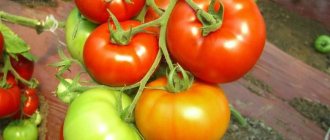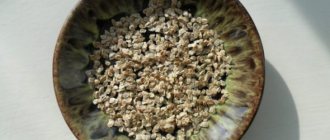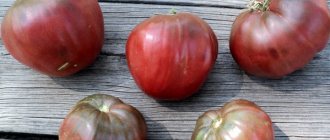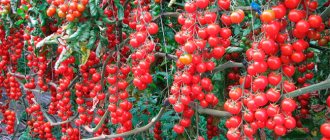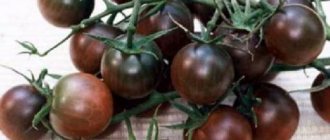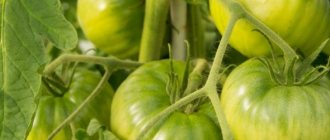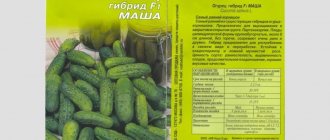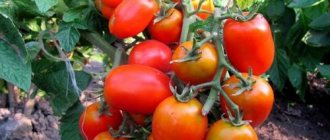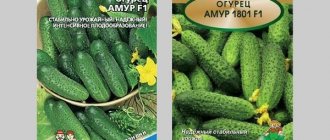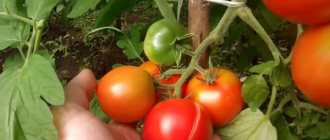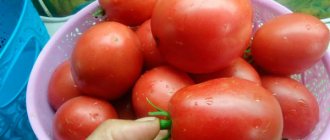» Vegetable growing » Tomatoes » Tomato hybrid Krasnobay f1
0
1217
Article rating
Tomato Krasnobay (F1) surprises with its yield. It is recommended to grow it in greenhouses and under film covers (planted in open ground only in the south). The first tomatoes ripen at the end of July, and the last ones in late autumn. For successful cultivation, it is useful to know the description of the variety, its characteristics, and also familiarize yourself with the recommendations of gardeners.
- Advantages and disadvantages
- We grow seedlings
- Transfer
- Tomato care
- Disease Prevention
- Reviews from gardeners
Tomato hybrid Krasnobay f1
The history of the hybrid
The Krasnobay tomato was registered in the State Register in 2008. The copyright holder is the Gavrish company, one of the leading companies among Russian seed producers.
The goal of the breeders was to create a plant suitable for cultivation in greenhouses and outdoors, with numerous and large fruits. Not the least attention was paid to the taste characteristics of the tomato. According to reviews from vegetable growers, biologists coped with the task. Krasnobay is a productive and unpretentious hybrid, with large and tasty fruits.
On a note! The difference between the first generation hybrid (f1) and the variety lies in the best characteristics taken from the parent forms. Hybrid plants are superior to their ancestors in yield and other characteristics. But the effect of hybridization persists only in one generation, without being transmitted further.
Which regions are best to grow in?
The tomato hybrid Krasnobay f1 gives a good harvest when planted in open ground only in the southern region of the country. Therefore, this vegetable is suitable for planting in greenhouses, which will ensure good fruiting in the northern regions of the country.
Description of the variety
This variety is a hybrid of the Russian collection; it was registered in 2008. Since then, this vegetable crop has been highly valued for its good varietal properties. Seed material is sold by the company Gavrish.
This hybrid is characterized by the average ripening time of tomatoes - from 120 days. The height of the bushes is more than 150 cm, they belong to the indeterminate type of development, standard. The leaves of the plant are medium-sized, dark green in color. Inflorescences are simple, located above 9–11 branches
The description of the variety states that it is intended for cultivation in closed ground. Therefore, in order to get a generous harvest, Krasnobay tomatoes need to be planted in high greenhouses. This plant has good resistance to fusarium, nematode and cladosporiosis.
Ripe fruits acquire a rich red color and their shape is slightly flattened. They weigh up to 400 g, and some specimens can grow up to 500 g. Tomatoes consist of five chambers, each of which contains an average number of seeds.
The high sugar content in Krasnobay tomatoes makes them very tasty. They eat vegetables fresh or canned, and also get excellent juice. They are used to make salads and pickles. Whole fruits are not placed in jars due to their large size.
The yield of the variety surprises even experienced gardeners, and reaches up to 14 kg per plant. If you plant tomatoes at a density of 3 bushes per 1 m2, you can achieve fruiting of about 30 kg. This is a good indicator.
Description of the bush
Krasnobay's bush is powerful, reaching a height of 2.2 m in a greenhouse and over 1.5 m in open ground. The foliage is medium in size and deep green in color. The first fruit cluster is formed after 10-12 true leaves, each subsequent one after 2-3 leaves.
Attention! To obtain large tomatoes, pinch the top of the plant after forming 8 clusters.
Fruit
Tomatoes have dense pulp and strong skin, are large in size, their weight is from 300 to 500 g. The shape of the fruit is round, with a perfectly smooth surface, slightly flattened. Color – intense red. The taste is classic, but not very pronounced.
The fruits are suitable for salads - the dense pulp holds the shape of the pieces well. Smaller tomatoes can be used for canning and pickling. Hard fruits are very convenient to freeze, dry, stew and bake.
Area of application of fruits
The Krasnobay tomato has dense pulp. Therefore, salads based on it turn out beautiful and tasty. The meaty slice does not get soggy and keeps its shape perfectly. You can preserve the pieces in gelatin. The appetizer turns out delicious and beautiful.
The juice and tomato paste from Krasnobay pulp are always thick. The fruits are suitable for whole-fruit canning and fermentation in barrels. Sun-dried tomatoes are surprisingly tasty.
Tomato Krasnobay
photo author Raisa Pyshkina
Description and characteristics of tomato Krasnobay F1, reviews, photos
Mid-late, indeterminate (unlimited growth), productive tomato hybrid. Recommended for growing in greenhouses.
The bush is tall and requires tying to a support and pinching. The best results were obtained when forming the plant into 1 stem.
The leaves of this tomato are medium sized and dark green. The inflorescence is simple. The first inflorescence is formed above the 9-11th leaf. It is advisable to pinch the growing point at the end of the growing season, leaving 7-8 clusters.
Basic qualities of fruits
The fruits are flat-round, dense, smooth, large, bright red in color at maturity, weighing 250-350 grams, good (for a hybrid) taste. These tomatoes are shelf-stable and transportable; they are suitable both for fresh consumption and for processing into tomato products. The dry matter content in fruit juice is 4.6-5.1%.
This hybrid is genetically resistant to cladosporiosis, fusarium and nematode.
The Krasnobai tomato is included in the State Register of the Russian Federation for growing under film covers in private household plots.
Seed producer : agricultural company Gavrish.
Features of cultivation, planting and care
Sowing seeds for seedlings is carried out 65-70 days before the intended planting in the ground. Dive - at the stage of two true leaves. When transplanting seedlings to a permanent place, 1 sq. It is recommended to place up to 4 plants per meter of prepared area.
Further care for tomatoes consists of timely watering (we recommend installing drip irrigation), weed removal, fertilizing with complex mineral fertilizers, pinching and preventive measures to protect the crop from diseases and pests.
High-yielding varieties of tomatoes from the company Gavrish, video
If you grew Krasnobay tomatoes, please write whether you liked them or not. What was the yield and taste of the fruits like under your climatic conditions? How do you rate the disease resistance of this hybrid? Briefly describe the advantages and disadvantages of this tomato in your opinion. If possible, attach to the comment a photo of the entire bush as a whole or individual fruits that you grew. Thank you!
Characteristics
Characteristics and description of the Krasnobay tomato variety:
- mid-late ripening;
- indeterminate standard variety;
- 120-125 days pass from planting to harvest;
- bush height from 1.5 m;
- average leaf sizes;
- the first inflorescence develops above leaves 9-11.
The fruits of the Krasnobai variety have a number of characteristic features:
- round, slightly flattened shape;
- dense smooth skin;
- rich red color;
- weight from 250 to 350 g;
- maximum weight – 500 g;
- dry matter concentration – up to 5.1%.
From 1 sq. m of plantings, up to 8 kg of fruits are harvested, subject to agricultural practices. The fruits last a long time and are suitable for long-term transportation. When picking Krasnobay tomatoes at the stage of technical maturity, they are left at home until ready.
According to reviews, photos and yields, the Krasnobay tomato is suitable for growing in garden plots and farms. Tomatoes are used for fresh consumption, preparing appetizers, salads, soups, sauces, and main courses. In home canning, the fruits are used to make salads, pickles, and tomato juice for the winter.
Krasnobai tomato productivity and fruiting
Productivity does not depend on temperature changes. It does not decrease in cloudy and cold summers. The Krasnobai tomato, even in an unheated greenhouse, demonstrates long-term returns.
Reviews from gardeners
The opinions of those who planted this variety often differ. Some gardeners are dissatisfied with the taste characteristics of the fruits, calling them too hard and tough. Others successfully use tomatoes for freezing, drying and preparing second courses, considering the dense pulp to be one of the advantages, thanks to which pieces of fruit do not spread and do not lose their shape.
Vegetable growers unanimously recognize the high yield of the variety. Sometimes it reaches a level much higher than expected - according to the description, up to 12 kg are collected from one bush.
If the fruits do not have time to ripen, gardeners pick them brown or greenish and successfully ripen them at home. Thanks to their excellent keeping quality, Krasnobay tomatoes are eaten until mid-winter, and sometimes longer.
Most note high resistance to diseases and unpretentious care. The most important thing is a well-ventilated greenhouse and timely watering. Despite certain shortcomings, the tomato has found its audience, who appreciate it for its excellent yield, relatively easy care and long shelf life.
What conditions does culture require?
Krasnobay needs a high level of soil fertility and a temperature during the growing period, not lower than +20 degrees. The variety is recommended to be placed in film greenhouses or polycarbonate greenhouses, providing regular fertilizing.
In the same greenhouse, it is not recommended to place tomatoes next to cucumbers (the plants need different growing conditions), peppers and eggplants (they have common diseases).
With an intensive growing method, the Krasnobaya bush is formed into 1 stem, cutting off all the stepsons and foliage to the first fruits.
For an uninterrupted supply of water and nutrient solutions directly to the bushes, a drip irrigation system is installed.
Planting and care
Taking into account the late period of fruit ripening, the hybrid is planted as seedlings 60-70 days before planting in the ground. Like all indeterminate tomatoes, Krasnobay is recommended to be grown in individual containers.
Optimal timing for sowing
Sowing of seeds is carried out approximately 70 days before the selected date of planting in the ground. It is not recommended to do this earlier or later, since in the first case the seedlings will outgrow, and in the second they will not have time to gain sufficient strength.
Planting seedlings
The method of growing Krasnobay tomato seedlings in “snails” showed good results. The seeds germinate quickly, they are easy to care for, and the plantings themselves take up little space. Picking sprouts is not difficult.
For planting you will need:
- small plastic bags;
- priming;
- stationery erasers;
- large plastic container.
It is very important that the soil is loose and moisture-absorbing. Fragile seedlings can easily get sick and die from fungal diseases in heavy, airtight soil. It is not recommended to use ordinary garden soil, as it cakes quickly. But, if there are no other options, then it is enriched with humus, peat, and sand is added as a leavening agent.
Pour soil onto a plastic bag, place the seeds at a distance of 2 cm and roll up the “snail”. Secure the rolls with rubber bands and place them in a plastic container with a small amount of water. When all the water is absorbed into the soil, cover the container with a bag until shoots appear.
When growing Krasnobay tomato seedlings, it is important to observe the temperature regime, since tall tomatoes quickly stretch. For germination they need +22 °C, after which the temperature is lowered to +18 °C. The room must be ventilated, but there should be no draft.
Shoots appear on the 5th day. The bag must be removed so that the sprouts are not blocked. In the future, caring for seedlings comes down to watering and fertilizing. Water carefully so as not to soak the seedlings.
Seedlings are picked in the phase of two true leaves. To do this, simply unwind the roll and remove the plants without damaging the roots. Seedlings are immediately placed in individual 500 ml containers.
Important! Seedlings are fertilized two weeks after picking. Mineral fertilizers are applied in low concentrations.
For Krasnobay seedlings, lighting plays an important role. Tall tomatoes develop quickly, and with a lack of light they become very elongated. To prevent this from happening, additional lighting lamps are used, and tomatoes are sprayed with growth regulators, for example, Athlete. The product stops the growth of the above-ground part, and directs all the strength of the plant to the formation of the root system and stem.
The soil
For complete germination of seeds of the Krasnoba variety, it is recommended to prepare a certain soil mixture. To do this, combine peat, turf soil and sand in the following ratio: 7:1:1. You can also purchase ready-made soil, which is sold in gardening stores, or regular peat tablets.
After some time, the soil is treated against pests and pathogens of various diseases. To do this, place the soil in the oven for about 20 minutes and calcinate it well. Finally, water generously with a 5% solution of potassium permanganate.
Growing container
Any container that has holes for draining excess liquid is suitable for germinating seeds. Whether these are separate cups or a common box depends on personal choice. In addition, you can use peat tablets (only they are a little more hassle, since you need to make sure that they do not dry out).
Features of cultivation
The main feature of this variety is its very high yield, which is why they love it. Another feature of this hybrid type of tomato is that it does not get along well with other tomatoes, so it is better to grow it separately.
Let's consider what needs to be done to properly grow the Krasnobay tomato. The plant is tall, so it needs a garter. The branches must be supported, since they bear a lot of fruit and there are many of them. Temperature and watering conditions should be carefully observed. This type of tomato responds very well to complex feeding.
Aftercare
Further care and feeding of tomatoes plays a decisive role for large-fruited tomatoes. The soil in the greenhouse should not be acidic, otherwise the nutrients will not be able to be absorbed, and the fruits risk becoming infected with blossom end rot.
According to reviews, during the entire growing season the Krasnobay tomato variety is fed 4 times. Alternate organic and mineral fertilizers. Good results are achieved by foliar foliar feeding, which can protect plants from a number of diseases and strengthen the immune system.
During dry periods, tomatoes are watered generously. The soil should not be allowed to dry out, otherwise the fruits will crack. Soil moisture should be constant.
To increase the yield from one plant, Krasnobay tomatoes are formed into 1 stem. In this case, up to the first flower cluster, all shoots and leaves are completely removed. Next, only the lateral stepsons are broken out, the leaves are thinned out as necessary.
Watering plants
Krasnobay tomatoes are watered weekly. Settled water heated in barrels is suitable for irrigation. Water is applied at the roots of plants, preventing it from getting on the leaves and stems.
The intensity of watering depends on the stage of development of tomatoes. Before the inflorescences form, they are watered with 4 liters of water. During the flowering period, tomatoes are watered using 2 liters of water every 3-4 days.
Advice! When the fruits ripen, Krasnobay tomatoes are watered less frequently to prevent cracking.
After watering, loosen the soil. This way plants absorb moisture and nutrients better. Mulching the beds with peat or humus helps maintain a high level of moisture.
Fertilizer application
Krasnobay tomatoes are fed 3-4 times during the season. There should be 14 days between procedures.
The first application of fertilizers occurs 7-10 days after transferring the plants to a permanent place. To feed the Krasnobay variety, a mixture of organic and mineral fertilizers is used. First, a solution is prepared consisting of mullein and water in a ratio of 1:10. 20 g of superphosphate is added to the resulting fertilizer.
Advice! For the second feeding, take 20 g of superphosphate and potassium salt. Substances are dissolved in water for irrigation or added dry to the soil.
Tomato Krasnobay F1. Stage VI. Results
Tomato Krasnobay F1 August 25.
Tomato Krasnobay F1. The final stage. Have a nice and sunny day everyone!
And autumn is already approaching, so I’m starting to finish my reports.
Daytime temperatures range from +10 to +17 degrees, and night temperatures drop to +4 degrees. The sun is no longer active, it is mostly cloudy, and it rains constantly. The tomatoes are no longer comfortable in the greenhouse - they don’t ripen well, and I no longer water them. For these reasons, I decided to harvest the entire tomato harvest and take stock of the tomatoes.
The photo shows a Krasnobay F1 tomato from the latest report.
The entire season - from the beginning of sowing to harvesting - the tomato developed, one might say, in extreme conditions - with large differences in sunny days.
On March 21, I sowed 10 Krasnobay F1 tomato seeds, provided by Gavrish for testing, in a mayonnaise jar with garden sandy loam soil. The soil was spilled with warm snow water.
And on March 27, 7 seeds sprouted, which amounted to 70% of the germination rate of those sown.
On March 30, the last 10th shoot appeared. Which showed excellent germination - 100%! And without any additions to regular garden soil!
April 2 is the beginning of the appearance of true leaves, and April 7.
... true leaves were observed in all seedlings.
On the same day, I picked the seedlings into separate containers, filling them with soil.
TERRA VITA
On the far left are transplanted tomato seedlings Krasnobay F1 - 5 pieces, the rest were given to a friend. For 2 days they were placed in partial shade, and then moved to a south window, where the daytime temperature in the room is +20 degrees and the night temperature is +16. +18 degrees.
On May 3, the seedlings were treated with HB-101 leaves to increase immunity to adverse weather conditions.
May 4 - transplantation into a polycarbonate greenhouse measuring 3 x 6 m.
At the time of planting the seedlings, it was wet snowing all day, and the air temperature varied from +2 to +7 degrees.
Tomato seedlings Krasnobay F1.
At the time of planting Root system of seedlings at the time of planting
5 bushes of tomato seedlings are planted in the middle of the bed, the width of which is 1.1 m, at a distance of 35 cm from each other. The soil is sandy loam with a pH of 7. Before planting, 1 teaspoon of granular AVA fertilizer and 1 tablespoon of bone meal were added to each hole.
After planting, the plants were covered with cardboard boxes and in arcs with covering material N60.
Fortunately, the seedlings are low, 20 cm high
Subsequently, watering was carried out as the soil dried out, followed by loosening. I fertilized Gumi-OMI once - 1 tablespoon per bucket of water.
On June 10, I gartered tomatoes and removed the lower leaves.
The shelters were removed, the plants stood under the boxes for only 2 days.
The first flower brushes appeared after 9 sheets, and the subsequent ones after 3 sheets.
After watering, I fertilized with monopotassium phosphate, since the bushes have a very thick trunk. Dissolved 1/2 tablespoon in a bucket of water. And I sprayed the bushes on the leaves with a solution of Epin-extra according to the instructions together with the addition of Fe with microelements (1.2 ml per 1 liter of water).
The weather is still changeable. During the day in the open ground +17. +28 degrees, and at night +4 degrees. In the greenhouse the daytime temperature is +26. +34 degrees.
The appearance of the first fruits. Powerful bushes, 90 cm high
After the next watering, I fertilized with granular phosphorus fertilizer Gumi-OMI (1 tablespoon per 1 square meter) and embedded it into the soil 2 cm deep. For better fruit set, I treated the flowers with Epin-Extra according to the instructions.
At this time, the weather was warm, + 35 during the day, and +20 degrees at night. Watering as the soil dries, followed by loosening around the bushes.
Beginning of fruit ripening.
The bushes are higher than 1.7 m, have 3 clusters with fruits. The brushes are without creases and adhere tightly to the bushes.
The weather did its disservice - a week-long heat of +47 degrees affected fruit set. The top flower clusters were burning, so we had to water the greenhouse itself from the outside and the path between the beds in the greenhouse several times a day! 2 open doors still didn’t help, there were no windows. And from August 1, the weather changed its mood, and until August 6, night temperatures remained at +6 degrees, and during the day only +15 degrees.
On this day, I treated the leaves and fruits with calcium chloride to prevent blossom end rot.
August 7 Ambient temperature +43 degrees, night temperature +12. +15 degrees.
It was in such extreme conditions that the harvest began.
On this day the following harvest was harvested:
1 bush - 2 pieces weighing 771 g 2 bush - 2 pieces weighing 510 g 3 bush - 3 pieces weighing 667 g 4 bush - 1 piece weighing 215 g 5 bush - without removal
Total: 8 pieces with a total weight of 2 kg 163 g
Weight of the largest:
437 g Within 11 cm in diameter, fruit shape is flat-round
I haven’t done a tasting yet; the fruits are not yet fully ripe.
5 tomato bushes Krasnobay F1 after removing the fruits in the middle of the bed.
As it grows, I remove all the stepsons; the foliage within 3 clusters with fruits is removed for better lighting. Watering was carried out once every 3 days, less abundantly, so that the fruits did not crack.
I continue harvesting.
General view of the bushes at the time of collection /photo from the side of the greenhouse wall/
1 bush - no collection 2 bush - 2 pcs. weighing 507 g 3 bush - 4 pcs. weighing 960 g 4 bush - 3 pcs. weighing 845 g 5 bush - 3 pcs. weighing 582 g
Total: 12 pieces with a total weight of 2 kg 894 g Total: 20 pieces weighing 5 kg 57 g
The collection was carried out from right to left according to the photo.
The largest of them is 415 g Type of tomato at the time of collection
1 bush - 5 pcs. weighing 1 kg 689 g 2 bushes - 2 pcs. weighing 749 g 3 bush - 2 pcs. weighing 671 g 4 bush - 6 pcs. weighing 1 kg 627 g 5 bush - 4 pcs. weighing 1 kg 336 g
Total: 19 pcs. weighing 6 kg 72 g Total: 39 pcs. weighing 11 kg 642 g
The author writes that the fruits are fragrant, tasty and tender. In my case, I do not observe such qualities. Let Gavrish forgive me, but it turned out just the opposite. The fruits are juicy, but without aroma, one might even say herbaceous. Ripening is very long; in my case, the tomato was taken from the harvest on August 7th. Very dense, thick-skinned and sour. I think that my conditions and agricultural technology are not suitable for them.
Can only be used for canning and for whole-fruit canning, very large ones.
I continue harvesting.
1 bush - 2 pcs. weighing 504 g 2 bush - 3 pcs. weighing 1 kg 118 g 5 bush - 2 pcs. weighing 440 g
Total: 7 pcs. weighing 2 kg 62 g Total: 46 pcs. weighing 13 kg 704 g
The weather is cold, +4 degrees at night, no higher than +17 degrees during the day. I have completely stopped watering for a week now. It’s only 1 degree warmer in the greenhouse, so I decided to harvest the entire tomato crop.
Unfortunately, the photos before the collection disappeared - the camera refused to open them for me.
Here's the latest collection:
1 bush - 11 pcs. weighing 923 g 2 bush - 12 pcs. weighing 998 g 3 bush - 9 pcs. weighing 1 kg 295 g 4 bush - 9 pcs. weighing 1 kg 202 g 5 bush - 10 pcs. weighing 1 kg 130 g
Total: 51 pcs. weighing 5 kg 548 g Total: 90 pcs. weighing 17 kg 190 g
The Krasnobay F1 tomato harvest is over!
Results and conclusions:
The Krasnobay F1 tomato is truly indeterminate. The ripening period, in my example, turned out to be within 127 days / for the author 115-120 / Grown in a polycarbonate greenhouse without heating. The fruits are flat-round, perfectly smooth, large, the largest is 437 grams. The taste did not impress me, quite the opposite. I don't plan to grow it. But still, huge gratitude to the Gavrish agricultural holding for the opportunity to work in its team. Many thanks to the 7 dach website for your patience and help with the work!
And finally, in conclusion, my recipe, which I have been using for many years. Maybe it will be useful for someone!
From the collection on August 7, I prepared a winter preparation of Uncle Bens with zucchini.
To prepare it you need tomato paste.
For this purpose, 2 kg of ripe tomatoes of this hybrid were turned into tomato juice. I’m omitting this procedure; I think that many housewives successfully cope with it.
To prepare Uncle Bensa you need:
- zucchini - 2 kg
- tomato paste, which is diluted with water to 1 l / I use 1 l of tomato juice, only thicker / - 0.5 l
- vegetable oil - 1 cup
- sugar - 0.5 cups
- salt - 1 tbsp. spoon
Pest and disease control
Reviews of Krasnobay tomatoes and photos of harvests show that with skillful care, the bushes rarely get sick and bear fruit abundantly. As a preventive measure, standard procedures are carried out to increase plant immunity.
In order to prevent late blight, the bushes are sprayed with a solution of serum with iodine. To 10 liters of water add 1 liter of whey and 15 drops of iodine. Spray shoots, fruits, leaves and stems of tomatoes.
Treatments with boric acid help get rid of a complex of diseases, compensate for the lack of boron in plants and stimulate flowering. It is useful to use a soap solution against pests and fumigate the greenhouse with a sulfur bomb before planting. The Colorado potato beetle often bothers tomatoes. Folk remedies or chemicals will help get rid of the pest.
Disease Prevention
Despite the high resistance of the Krasnobai variety to diseases, mandatory prevention cannot be ignored, otherwise the tomato may produce a yield lower than declared.
Mandatory procedures include: maintaining proper crop rotation, ventilating the greenhouse, weeding and loosening the soil (or mulching), thinning leaves, watering with manganese, and sprinkling the beds with ash.
To prevent brown spot, you can spray tomatoes with copper oxychloride, and if there are obvious signs of the disease, use special agents (oxychome or foundationazole).
To avoid pest invasion, bushes need to be inspected regularly. Slugs and caterpillars are collected from the leaves by hand, aphids and whiteflies are washed off with a soap solution. To prevent wireworms, the mulch in the garden bed is impregnated with urea.
If the pest infestation becomes serious, it is necessary to use chemicals - insecticides and acaricides.
